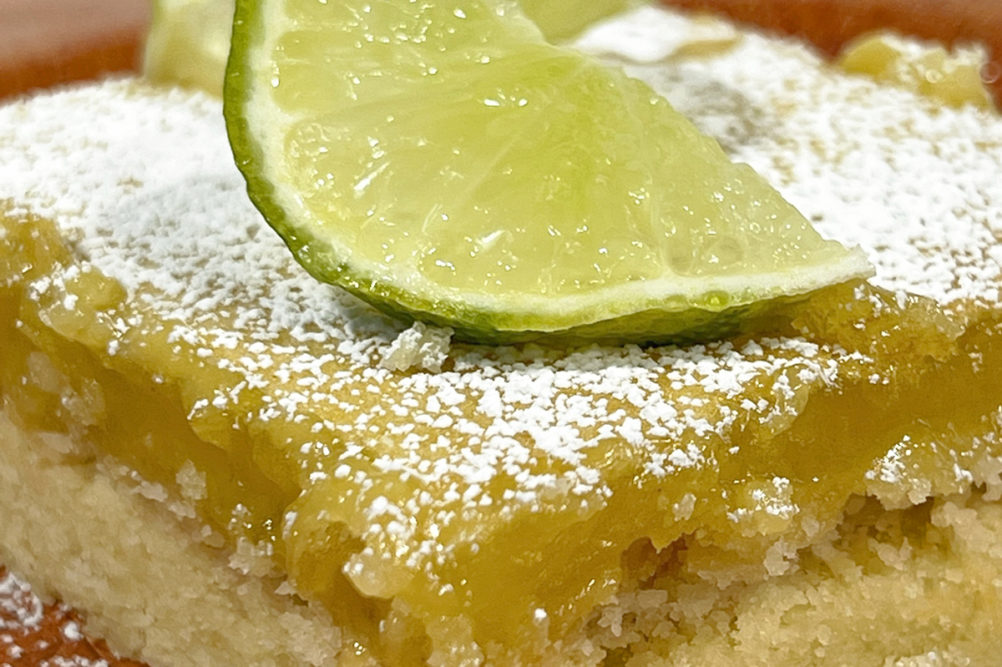Bakers will love Lime Zest in recipes such as key lime Bars; lime shortbread cookies; and milk chocolate almond & lime cookies from Toni Roberts, pastry chef at the Ritz-Carlton Chicago. The Perfect Purée of Napa Valley, the leading U.S. producer of premium fruit purées for culinary and beverage professionals, recently introduced Lime Zest, joining Lemon Zest and Orange Zest to round out The Perfect Purée’s family of zests.
The Perfect Purée is celebrating the start of its 35th year. Zesting fruit by hand can be a labor-intensive process (not to mention hard on the knuckles!) which is why Orange Zest and Lemon Zest are especially revered by bakers who rely heavily on zests. With the addition of Lime Zest, The Perfect Purée encompasses 41 products that help busy chefs maintain quality and consistency and save time in the kitchen. Their zests have crossed into the bar as well, adding a special zing to craft cocktails and zero-proof creations.
Lime Zest brings texture, mouthfeel and natural lime flavor from oil found in the rind to desserts, sauces and more. In cocktails, it lends more intense lime flavor than juice. The Perfect Purée of Napa Valley Co-president and chief marketing officer Michele Lex says its creation was the logical next step in the company’s collection of zests.
“Lime Zest will be a valuable time-saver without compromising flavor,” Lex says. “Lime Zest has been requested by our end users for many years and we are happy to finally make it for them. The flavor will help us broaden our ability to provide premium and convenient flavor for culinary and beverage innovation at thousands of establishments nationwide.”
International flavors
With their surprising taste and intense flavor, two endemic fruits - introduced to the international market at the end of the 20th century - will stimulate the creativity of restaurateurs, pastry chefs and mixologists all over the world, surprising their customers by disrupting their taste experience.
For nearly 80 years, Les vergers Boiron has concentrated all its energy and experience on developing fruit solutions to release the creative talent of chefs, pastry chefs and mixologists all over the world. In 1970, Les vergers Boiron invented the first frozen fruit puree using its unique know-how: rigorous selection of the best varieties and terroirs, mastery of the art of blending, guaranteeing a constant flavor season after season, and preservation of organoleptic qualities with a specific process for each fruit.
Acai: a wild berry from the Amazon delta
Acai was originally used by the Amazon peoples as an alternative to rice, eaten in the form of a bread to which cassava and sugar were added. This highly fragile fruit degrades quickly after being picked, so must be eaten fresh, close to where it is grown. Now enjoyed all over the world, this “superfruit” is appreciated for its antioxidant powers and high fiber content.
For their frozen acai puree, Les vergers Boiron use fruit from the banks of the Amazon delta, in the north-east of Brazil. This tropical, humid, marshy region offers all the conditions needed to grow the trees, which fill up with the nutrients present in the flood water. A cooperative of 19 producers picks the fruit by hand, over a period of four months, from mid-August to mid-December.
“Acai is a trendy, healthy fruit with an exotic touch that is very interesting to work with. I've been impatiently waiting for it to join the Les vergers Boiron frozen fruit purees without added sugar range,” comments Thibault Marchand, corporate chef at Les vergers Boiron. “The purple-coloured puree and relatively liquid texture reveal notes of black olive, red fruit and walnut oil, plus lightly salted notes.
“It’s a wonderful source of inspiration for creating desserts with different textures: sorbets, cremeux, pastry creams, acai bowls and smoothies. It can also be used in savoury recipes. The combination possibilities are infinite: red fruits, bananas, blueberries, coconut, blackberries, granola, chocolate, olive oil, almonds, vanilla and fromage blanc.”
Sudachi: a citrus fruit from Japan
Native to Tokushima Prefecture in the north-east of the Japanese island of Shikoku (south of Osaka), sudachi is a citrus fruit that has been grown since the 8th century. Today, 90% of sudachi volumes come from this region.
Sudachi production is almost confidential - only 3,000 tonnes of fruit are picked each year, and the yield is very low, only 1kg of juice for 4kg of fresh fruit. Grown in small plots (1/4 hectare) at between 300m and 400m in altitude, the fruit is picked from the owners’ trees by local cooperatives, before being processed into juice.
The raw materials selected by Les vergers Boiron for its sudachi puree come from two cooperatives known for their compliance with EU standards on fruit processing. The sudachi are picked by hand, still green, from September to early November, so they retain the pronounced tanginess, typical of the fruit.
“Sudachi puree is different from other citrus purees due to its peppery notes and powerful acidity, naturally balanced by a slightly sweet flavor. This gives it a highly innovative use in pastry recipes,” continues Marchand. “It can be easily worked into a sorbet, cremeux, confit or mousse and blends perfectly with coconut, cereals, mango, green shiso, basil, almond, hazelnut, chocolate, pear, tonka beans, praline or gin.”




